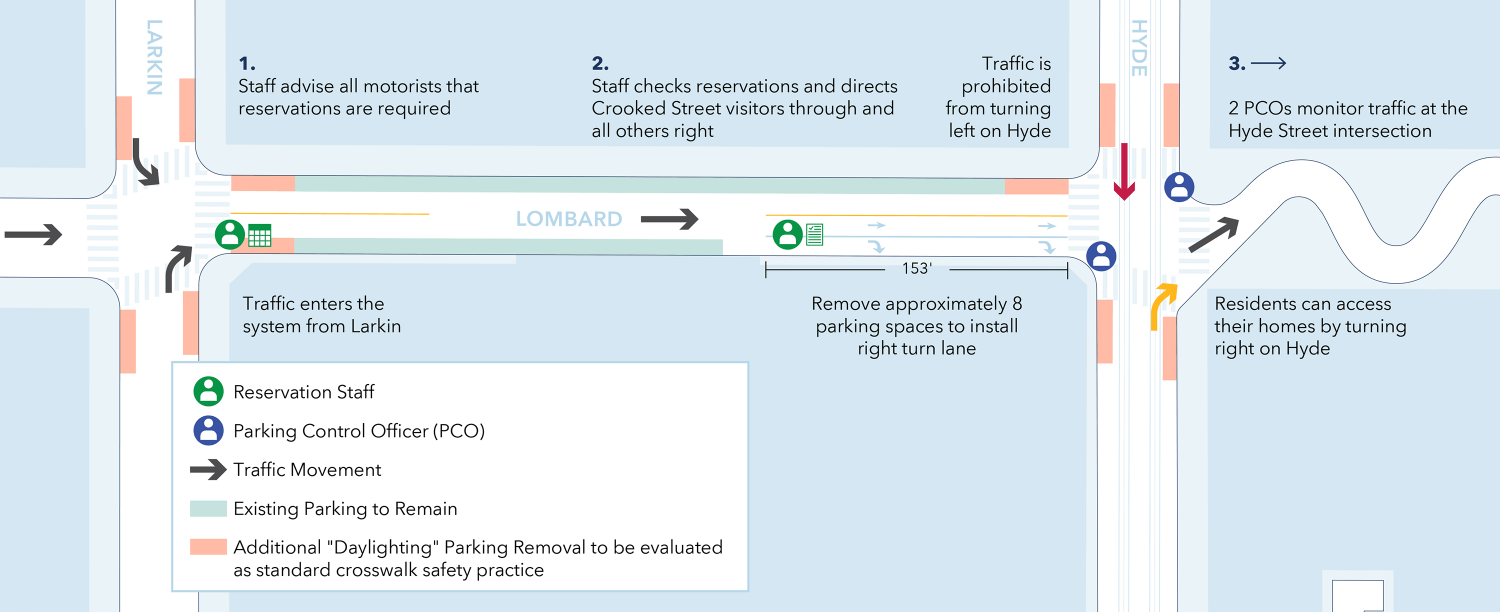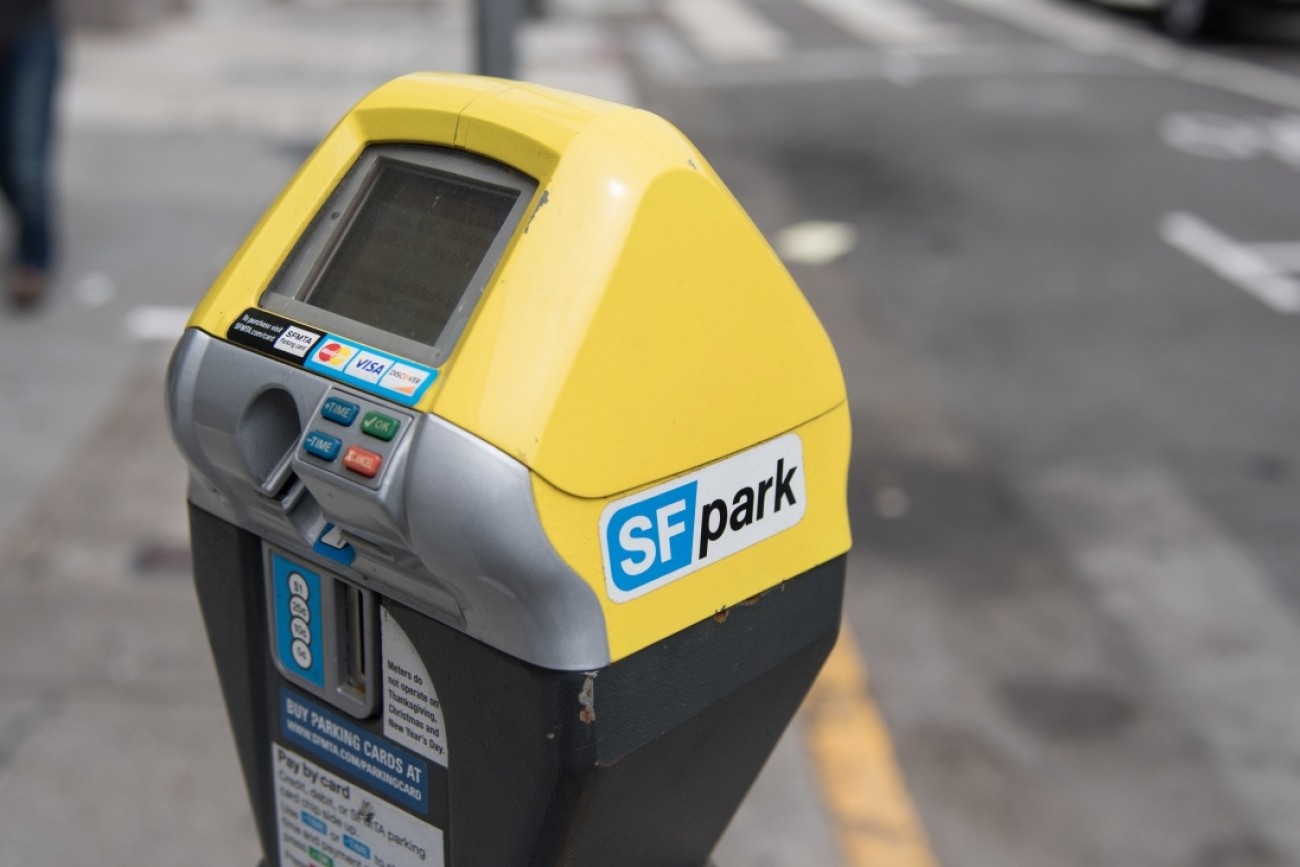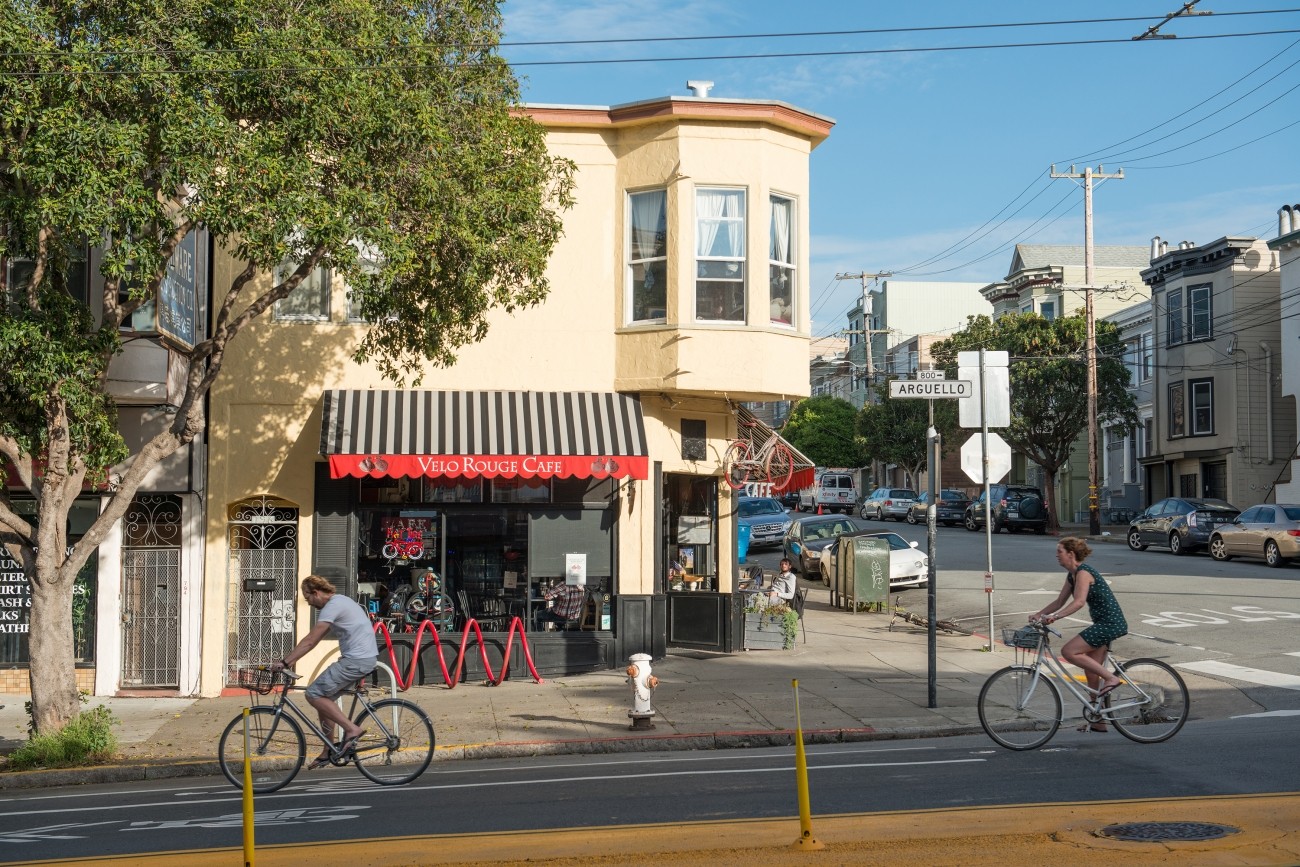
Photo: Peter Lee, flickr
Introduction
The “crooked” section of Lombard Street is both a residential neighborhood and one of the most popular tourist destinations in San Francisco, drawing approximately 2 million visitors each year.
As overall tourism in San Francisco has increased, so has the number of tourists on the street, and crowd control issues around the area have become more challenging. The Transportation Authority conducted studies that found a reservation system could alleviate congestion in the area.
Timeline & Status
2017: The Transportation Authority released a study with recommendations for addressing congestion on the Crooked Street, including a reservations and pricing system for vehicles.
2019: The Transportation Authority completed a second study (PDF) on design options of a paid reservations system and how it could successfully address traffic congestion while ensuring safety, financial viability, continued tourism, and livability of the surrounding neighborhood. In October, Governor Gavin Newsom vetoed AB 1605, which would have authorized San Francisco to establish a reservation and pricing pilot program for Lombard Crooked Street. The bill was authored by Assemblymember Phil Ting and had passed through the state legislature.
2020: Following the Governor’s 2019 veto of legislation that would have authorized a paid reservation program, the Transportation Authority is working with local and state lawmakers on new legislation to allow for a no-fee reservation system.
Cost and Funding
This project is supported in part by the Transportation Authority's Neighborhood Program at the request of District 2 Supervisor and Transportation Authority Board Member Catherine Stefani.
Project/Study Partners
- SFMTA
Resources
View the 2017 and 2019 reports and related documents
Contact
info@sfcta.org
What We Studied: Paid Reservations System
A reservations system for vehicles, similar to the one recently implemented at Muir Woods, could address most of the neighborhood’s existing challenges with traffic. Vehicles would be required to make a paid reservation to visit Lombard Crooked Street.
In the 2019 study, the Transportation Authority developed a solution targeted at:
- Managing auto congestion
- Maintaining livability of the surrounding neighborhood
- Managing pedestrian congestion
- Ensuring traffic safety
- Implementing a financially viable solution
- Preserving tourism at a sustainable level
The Transportation Authority recommended a system that:
- Operates 9:00 a.m. to 9:00 p.m.
- Costs $5 on weekdays, $10 on weekends and holidays
- Includes staff to check reservations and help direct vehicles
- Allows for a limited number of free passes to San Francisco residents through the city's Discover and Go program.
How a Paid Reservations System Could Work
Lombard Today: Unmanaged auto traffic creates significant congestion, delay, and pollution in the residential neighborhood surrounding the Crooked Street for up to 10 hours of the day.
Lombard with a Paid Reservations and Pricing System: With a reservation system in place, arriving vehicles are spaced at reasonable intervals to significantly improve congestion for neighborhood residents and save time for visitors.
As illustrated in the diagram, the operation of the system depends on the presence of Parking Control Officers, or PCOs, to help direct traffic and two or more reservation system staff members (who are not PCOs) that will verify reservations on site. Additionally, to manage the flow of vehicles, this design proposes removing a minimum of eight on-street parking spaces on Lombard near the intersection of Lombard and Hyde to create a right-turn-only lane for vehicles without reservations to be directed away from the street.
Policy & Technical Needs
There are many questions that would need to be answered before a paid reservations system on the Crooked Street could be implemented.
On the policy side, additional work must determine what entity would govern and oversee the program, including setting the price for a reservation to access the Crooked Street, as state legislation would be needed to authorize these activities. The designated reservations management entity would likely also be considered to serve as the overall management agency for the Crooked Street, which would lead other functions to manage the street as a tourist attraction.
Multiple technical and operational questions would also need to be answered and informed by further analysis, including demand and financial modeling, and determining what entities should lead planning, design, environmental review, construction, operation, and maintenance of the system.
2017 Study: Managing Access to the "Crooked Street"
In 2017, the Transportation Authority released a study on managing access to the “Crooked Street”—a residential segment of Lombard Street that is also one of San Francisco’s most prominent landmarks. The crooked segment of Lombard Street attracts approximately 2 million visitors each year.
The study was recommended by former District 2 Supervisor and Transportation Authority Board Member Mark Farrell as part of the Neighborhood Program and was conducted in partnership with the SFMTA.
The purpose of the study was to identify and evaluate a range of options to manage visitor access and circulation on Lombard Street between Hyde and Leavenworth streets, while maintaining the character of the block and avoiding spillover effects into adjacent streets. The study’s approach included goal-setting, existing conditions analysis, alternatives development, public outreach, and evaluation.
The Transportation Authority published the Managing Access to the "Crooked Street" (PDF) study in 2017 outlining recommended short- and mid-term strategies to inform future planning, analysis, and development to resolve the unique challenges facing the Crooked Street and its surrounding neighborhoods.
The Transportation Authority compiled a wide range of potential interventions and improvements and evaluated how well each would meet one or more of the study’s goals. A short list of options for further study were presented at two public meetings in the fall of 2016, accompanied by a feedback form that community members could respond to online and/or in person.
Study Recommendations
The final report adopted by the Transportation Authority Board recommended four strategies for further planning, analysis, and development. These strategies can be implemented in the short- and mid-term.
Improved Enforcement of Existing Regulations
Based on Transportation Authority’s outreach, it was clear there is widespread consensus among community members that more robust enforcement of existing regulations could help address perceived traffic circulation and safety issues on the Crooked Street. One strategy, which received considerable support in public feedback, would be to increase the number of SFMTA Parking Control Officers, expanding their hours of deployment and the locations they patrol. This strategy would build off the “eyes on the street” function played by neighborhood residents and is currently supplemented by the Lombard Ambassadors managed by the Mayor’s Office of Economic and Workforce Development.
Engagement of Tourism Industry as Partners in Visitor Management
Among the solutions identified is the creation of an education and marketing campaign/partnership with the San Francisco Travel Association (SF Travel), tour operators, rental car companies, and hotels. Since many tour operators bring groups to experience the Crooked Street, this effort is an opportunity to remind operators directly about how to be a good neighbor, in terms of tour group size, timing, and loading/unloading. By helping visitors make better informed decisions about when and how to access the Crooked Street, the education campaign could have a positive impact on automobile and pedestrian congestion, as well as resident and visitor access to the Crooked Street. In turn, traffic and personal safety could also improve.
Engineering and Signage Enhancements
Traffic engineering interventions—such as painted or raised sidewalk extensions, barriers, or wayfinding signage—could help to address conflicts and near-misses between pedestrians, drivers, and transit. Additional opportunities for signage enhancements, could include estimated wait times for vehicles in the queue to drive down the Crooked Street, and encouragements for drivers to lock vehicles and to leave personal belongings out of sight when parking in the area.
Reservations and Pricing System for Vehicles
One of the most direct ways to manage automobile congestion, including the vehicle queues that form at peak periods, would be to implement a system to manage paid reservations for access to the Crooked Street. Similar to how museums limit the number of tickets available at any given time for popular exhibits, and allow those who plan ahead to reserve a time in advance, this strategy would allow for the flow and demand of automobiles entering the Crooked Street to be regulated, reducing queue lengths.
The primary goal of the system would be to manage demand while being self-sustaining, and prices and number of available reservation slots would be set per this goal.
What We've Heard
We have hosted three open houses, conducted surveys, and held meetings with residents, neighbors, and businesses.
Here's what we've heard:
- The day-to-day impact of congestion on quality of life is real and it is negative.
- Managing vehicle congestion and maintaining livability in the neighborhood are the top two community goals of any solution.
- Solutions should reduce other impacts like litter, wayfinding, and air quality.
- There is strong community support for a reservations and pricing system to address traffic and tourism challenges.
January 30, 2019, Community Meeting
The Transportation Authority is studying a reservation and pricing system to better manage traffic flow on the crooked section of Lombard Street. On January 30, 2019, we hosted an open house to share details about how this proposed system could work and gather community feedback.
Additional opportunity for feedback:
Learn more about the proposals and submit an online feedback form.
Community meeting resources:
Poster boards (PDF)
PowerPoint presentation (PDF)
What's next
The project team will use community feedback to refine our proposal for a reservation and pricing system for Lombard. In summer 2019, we expect to present our final recommendations to the San Francisco Board of Supervisors in its capacity as the Transportation Authority board. Our board will then provide direction on next steps.
Sign up for email updates to learn about upcoming public meetings and opportunities for engagement.
2019 Study
Final Report: Lombard Crooked Street Reservation and Pricing System Study, 2019 (PDF)
Lombard Crooked Street Data Collection Plan
Lombard Crooked Street Data Collection Summary
Lombard Crooked Street Scenario Performance Memo
Lombard Crooked Street Operational Scenario Screening & Development Memo
Lombard Paid Reservations System Draft Concept of Operations



